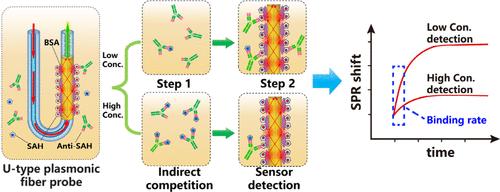Ultrafast Detection of Small Molecules Using a U-Shaped Transmission Terminal and Straight Plasmonic Sensing Region Fiber Probe Biokinetic Platform: A Case Study of Label-Free Hcy Detection via Indirect Competitive Immunoassay
IF 6.7
1区 化学
Q1 CHEMISTRY, ANALYTICAL
引用次数: 0
Abstract
Immunoassays face significant challenges, including the precise measurement of small molecules, rapid testing, and background interference. This study constructs a biokinetic sensing platform using a late-model plasmonic fiber probe that incorporates an indirect competitive immunoassay system on its surface for the rapid detection of target small molecules. Our plasmonic fiber probe transforms the conventional online transmission-type fiber surface plasmon resonance (SPR) into a probing structure with a U-shaped fiber termination, preserving the high performance of a straight fiber SPR sensing region and enabling direct sample detection via an insertable probe. Taking the detection of homocysteine (Hcy), a key indicator of cardiovascular diseases, as an example, our fiber probe has achieved rapid immunoassay for small molecules within 10 s while eliminating background interference by measuring target molecular binding rates. The probe sensitively identifies concentration gradients based on binding rates, even in serum, demonstrating high selectivity. The Hcy detection range is 0 to 100 μM, covering low to high abnormal concentrations typically observed in humans, with a detection limit of 2.23 nM. This fiber-optic kinetic method provides rapid, accurate Hcy testing; and multichannel networked potential for various small molecules, macromolecules, and genes detection.

利用u型传输终端和直等离子体传感区光纤探针生物动力学平台进行小分子超快检测:间接竞争免疫法无标记Hcy检测的案例研究
免疫分析面临着巨大的挑战,包括小分子的精确测量、快速测试和背景干扰。本研究利用新型等离子体光纤探针构建了一个生物动力学传感平台,该探针在其表面结合了间接竞争免疫分析系统,用于快速检测目标小分子。我们的等离子体光纤探针将传统的在线传输型光纤表面等离子体共振(SPR)转变为具有u形光纤终端的探测结构,保留了直光纤SPR传感区域的高性能,并通过可插入探针实现了直接样品检测。以检测心血管疾病的关键指标同型半胱氨酸(Hcy)为例,我们的纤维探针通过测量靶分子结合率,实现了10 s内对小分子的快速免疫分析,同时消除了背景干扰。该探针灵敏地识别基于结合率的浓度梯度,甚至在血清中,显示出高选择性。Hcy检测范围为0 ~ 100 μM,可覆盖人体常见的低到高异常浓度,检测限为2.23 nM。这种光纤动力学方法提供了快速,准确的Hcy测试;和多通道网络的潜力,各种小分子,大分子,和基因检测。
本文章由计算机程序翻译,如有差异,请以英文原文为准。
求助全文
约1分钟内获得全文
求助全文
来源期刊

Analytical Chemistry
化学-分析化学
CiteScore
12.10
自引率
12.20%
发文量
1949
审稿时长
1.4 months
期刊介绍:
Analytical Chemistry, a peer-reviewed research journal, focuses on disseminating new and original knowledge across all branches of analytical chemistry. Fundamental articles may explore general principles of chemical measurement science and need not directly address existing or potential analytical methodology. They can be entirely theoretical or report experimental results. Contributions may cover various phases of analytical operations, including sampling, bioanalysis, electrochemistry, mass spectrometry, microscale and nanoscale systems, environmental analysis, separations, spectroscopy, chemical reactions and selectivity, instrumentation, imaging, surface analysis, and data processing. Papers discussing known analytical methods should present a significant, original application of the method, a notable improvement, or results on an important analyte.
 求助内容:
求助内容: 应助结果提醒方式:
应助结果提醒方式:


